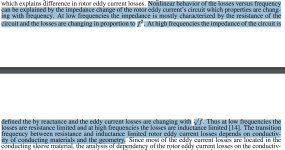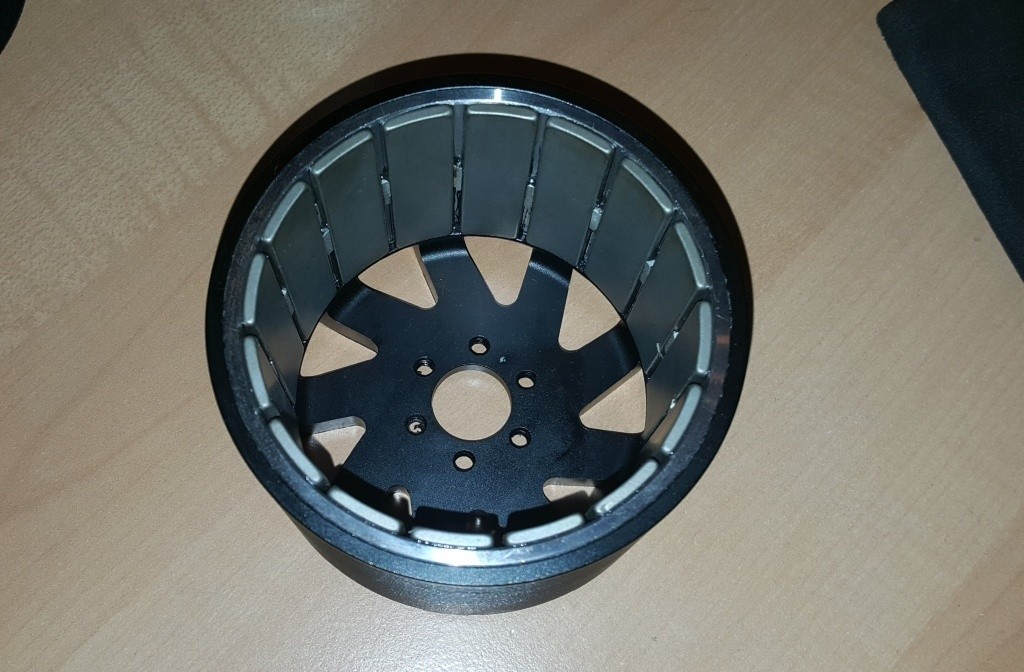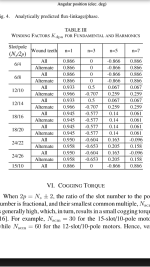ElectricGod
10 MW
blank entry
ElectricGod said:These are my comments and conclusions based on the "Rotor Eddy-Current Loss in Permanent-Magnet Brushless AC Machines" article.
...
"However, for high frequency harmonics or when a metallic retaining sleeve with high electric conductivity is used, the skin depth becomes small and the resistance limited assumption may not be valid."
A "metallic retaining sleeve" implies an outrunner or hub motor in my mind. in the previous paragragh is this:
"They are based on the assumption that the magnets are surface-mounted and the eddy currents are resistance limited, i.e., the relatively high resistivity and low permeability of permanent magnets will limit the amplitude of induced eddy currents and the reaction field produced by the eddy currents is negligible,"
I'm not sure about the "resistance limited" or "high resistivity" statements. Are they references to electrical resistance or something else? I have a "peeled neo". It wouldn't be hard to check the resistance of the magnetic material. IF this is a reference to the electrical conductivity of the magnet, then the WORST possible coating for them would be chrome! Chrome would magnify the amplitude of the eddy currents. IF this is a reference to some characteristic of magnets that is NOT electrical resistance then right away in the introduction, this article says that electrical conductivity and its effects on eddy currents "is negligible" and "may not be valid". I'll keep reading, but that's my conclusions so far.
"To reduce rotor eddy current loss, each pole of magnets is segmented into four pieces."
"As will be seen from Fig. 4, the stator current excitation produces a 2-pole rotating magnetic field which can penetrate deeply into the rotor magnets, resulting in significant eddy-current loss if the magnets are not segmented. As the number of segments per pole increases, the eddy-current loss decreases. However for the machine under consideration, the rate of reduction in eddy-current loss diminishes as the number of segments is greater than 4."
"It has been shown that forward and backward rotating space harmonics of different orders may result in the same frequency seen by the rotor. Therefore, when more than two segments per pole are employed in PM machines, the loss in each segment may be significantly different. Such nonuniform distribution of eddy-current loss will inevitably give rise to uneven temperature distribution and increases the
risk of partial irreversible demagnetization."
Clearly segments of magnets reduce eddy current losses. It is also stated several times that not all segments of magnets that make up any pole will have the same losses. One segment will probably have much higher losses than the others which means that one magnet segment gets much hotter than the others. I don't honestly know why they bothered with segmented magnets. It's not practical for a manufacturer to do this and the fact that magnets in the same pole won't have the same loses means lots of new issues. Why bother at all? The implications, complications and caveats are possibly worse than having single segment magnets like any motor I've ever seen has. IMHO segmented magnets sounds like it's just not worth the trouble. I suppose since this study is about reducing eddy currents, then it's applicable to the study, but in the practical real world, fairly pointless.
In conclusion, from this article, I see no where that they state that electrical conductivity between the magnets and the armature back iron is relevant.




I think the first part "...between the magnets..." refers to between magnet poles which we agree on above.ElectricGod said:Electrical conductivity between the magnets or between the magnets and the back iron in the armature is irrelevant.


thepronghorn said:Lol I spent like four hours reading and writing this post, so hopefully we can get this useful conversation moved to its own topic.
Actually the Joby motors do have two (2) pcs fully segmented magnets (FMS) per pole[*]This is why some "nice" motors have segmented magnets (Emrax) and some "nice" motors do not (Motenergy is a bad example - it is just a big motor, most Joby motors I have seen pictures of are "nice" and do not have segmented magnets).
I do not think that madin88's comparison of not isolating vs isolating magnets to SSPMS vs DSPMS is quite accurate. The purpose of segmentations/laminations is to intersect/block the induced currents from the moving magnetic field. The magnetic field decreases in strength as you move away from the stator/into the rotor. The first thing you reach is the magnets. Segmenting the half of the magnet closest to the stator ala SSPMS decreases rotor eddy current losses in the first half of the magnet as seen in the figure below.
.....
Comments welcome.
(larsb's article referenced above linked here: https://scholar.sun.ac.za/bitstream...ills_reducing_2010.pdf?sequence=2&isAllowed=y)

thepronghorn said:As we move deeper into the magnet past the segmentations, rotor eddy current losses increase back to normal since we are no longer segmented and nothing exists to intersect our eddy currents.
However, if we segment the second half of the magnet (the half that is further from the stator) ala DSPMS, we significantly decrease rotor eddy current losses in the second half of the magnet while losses in the first half of the magnet only decrease marginally from SSPMS.
Yup that looks like a very well designed motor.larsb said:Speaking about segmented magnets and that most manufacturers don't use them: the QS 3000W mid drive motor has segmented magnets.
5 pole pairs, 40 magnets total equals 4 magnets per pole.
Efficiency 89% with drive losses included according to QS. That's sweet if it's correct!
John in CR said:Assuming a significant portion of the no load losses are on the rotors of the motors you guys are looking at (are the cans heating up faster than the stator?), could the real problem be insufficient back iron? Since there's little enough back iron that flux leaks all the way through, then it would seem flux changes in the back iron during operation could be more pronounced.

larsb said:...the rotor heats up instantly at no load with no heating of the stator.
larsb said:Another thought i have is that the magnets overhang the stator by 6mm. I guess that will increase the torque but also cause some of the endturn flux to be linked.
Are magnets larger than the stator on high quality motors?
 View attachment 1
View attachment 1larsb said:I would like to understand graphs like these:
image.pngimage.png
From this paper:
Zhu paper.pdf
